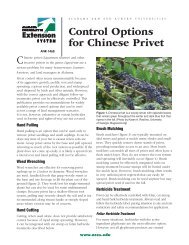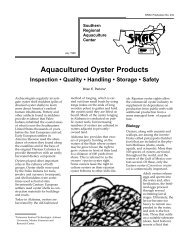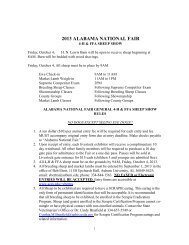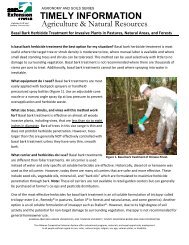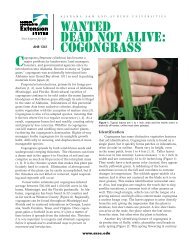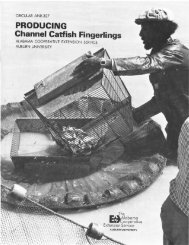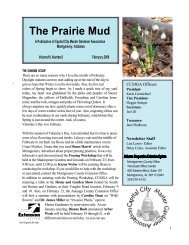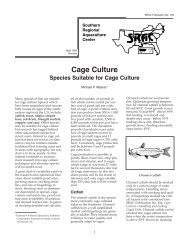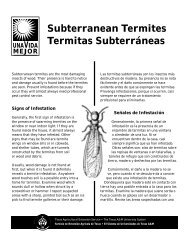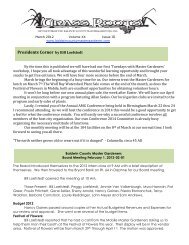Chapter 11--Rosgen Geomorphic Channel Design
Chapter 11--Rosgen Geomorphic Channel Design
Chapter 11--Rosgen Geomorphic Channel Design
Create successful ePaper yourself
Turn your PDF publications into a flip-book with our unique Google optimized e-Paper software.
<strong>Chapter</strong> <strong>11</strong><br />
POWERSED<br />
<strong>Rosgen</strong> <strong>Geomorphic</strong> <strong>Channel</strong> <strong>Design</strong><br />
<strong>11</strong>–46 (210–VI–NEH, August 2007)<br />
Part 654<br />
National Engineering Handbook<br />
A generalized flowchart depicting the POWERSED model is shown in figure <strong>11</strong>–25, and a graphical depiction of<br />
the model is shown in figure <strong>11</strong>–26.<br />
Evaluate channel characteristics that change hydraulic and morphological variables—Changes in the cross<br />
section and/or pattern (slope) for potentially impaired reaches are measured to determine width, depth, slope<br />
and calculated velocity. Comparisons are made between hydraulic characteristics of the reference versus the<br />
impaired reach. This analysis is used in the bed-load transport model (POWERSED) or in a comparable bedload<br />
model selected by the user. Shear stress and unit stream power are calculated using equations <strong>11</strong>–2 and<br />
<strong>11</strong>–7:<br />
τ=γdS (eq. <strong>11</strong>–2)<br />
where:<br />
γ = specific weight of the fluid<br />
d = mean depth<br />
S = water surface slope<br />
Unit stream power or power per unit of streambed area (ω a ) is defined as:<br />
ω a =τu (eq. <strong>11</strong>–7)<br />
where:<br />
τ = bankfull shear stress (lb/ft 2 )<br />
u = mean velocity<br />
POWERSED can be used to simulate hydraulic geometry (width, depth, slope, velocity, and discharge) for a<br />
wide range of stages for reference and impaired reach hydraulic evaluations. POWERSED can also be used<br />
to compute changes in hydraulic character due to modified channel dimension, pattern, profile or materials.<br />
This information is used to determine changes in unit stream power for increased or decreased discharge.<br />
This model predicts channel stability response to imposed sediment load, change in flow, and/or change<br />
in distribution of energy due to channel change. The model determines sediment transport and predicts<br />
aggradation, stability, or degradation, depending on the nature and extent of the channel and/or flow change.<br />
The hydraulic/sediment departure is compared to the corresponding reference or stable condition. A recent<br />
comparison of predicted to observed values on an independent data set was shown in <strong>Rosgen</strong> (2006) where<br />
predicted annual sediment yield values were predicted within 3 percent of measured values for a C4 stream<br />
type and within 6 percent of measured values for a D4 stream type on Weminuche Creek, Colorado.<br />
Calculate bed-load and suspended sand-bedmaterial load transport (stream power)—Bed load and suspended<br />
sand-bed material load transport calculations may use various equations, such as the Bagnold equation. The<br />
POWERSED model (figs. <strong>11</strong>–25, <strong>11</strong>–26 and tables <strong>11</strong>–12 and <strong>11</strong>–13) assists in the analysis of sediment transport<br />
and channel response. This model was developed to predict the effects of channel instability and sediment<br />
supply changes in sediment transport. Other bed-load and suspended sand-bed material load transport models<br />
can be employed by the user, based on familiarity with and calibration/validation of the model for application<br />
to the particular stream types being analyzed.<br />
The POWERSED model applies the suspended sand-bed material and bed-load sediment rating curves/flow<br />
duration/revised unit stream power-transport curves or a comparable model selected by the user to predict<br />
sediment transport and channel stability. The prediction includes river stability and total annual bed-load sediment<br />
yield in tons/year. The equations or computer program generates a change in coarse bed-load transport<br />
that will be influenced by changes in channel cross section and/or slope. Changes in streamflow, velocity, unit<br />
stream power, critical dimensionless shear stress, and other variables due to land use changes predict changes



